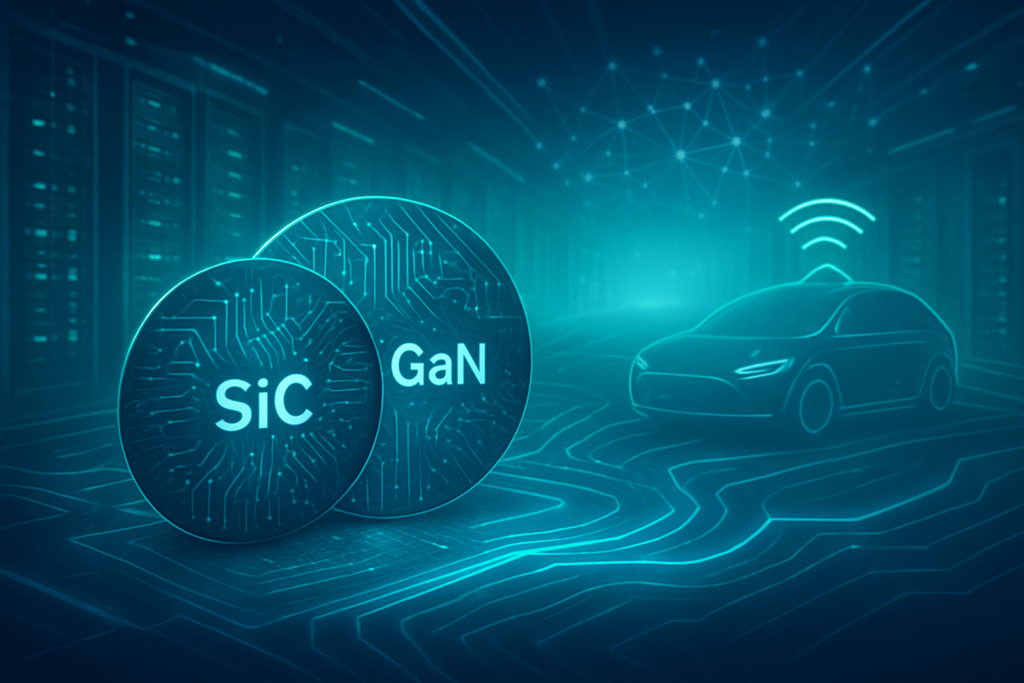
ON Semiconductor (NASDAQ: ON) has unveiled its financial outlook for the fourth quarter of 2025, projecting revenues between $1.48 billion and $1.58 billion. This guidance, released on November 3, 2025, alongside its third-quarter results, offers a crucial glimpse into the company's anticipated performance and strategic direction in a rapidly evolving semiconductor landscape. The forecast, which largely aligns with market consensus, suggests a period of strategic re-calibration for the power and sensing solutions provider as it focuses on high-growth segments like automotive, industrial, and AI.
The Q4 2025 projections come at a pivotal time for the semiconductor industry, which has seen fluctuating demand and supply chain adjustments. ON Semiconductor's ability to provide guidance that encompasses analyst expectations, with an anticipated adjusted earnings per share (EPS) between $0.57 and $0.67 and an adjusted gross margin of 37% to 39%, indicates a measured approach to navigating current market conditions. This forecast is a key indicator for investors and industry observers, offering insights into how the company plans to sustain its market position and drive future growth amidst both opportunities and challenges.
Detailed Financial Projections and Market Context
ON Semiconductor's Q4 2025 revenue forecast of $1.48 billion to $1.58 billion is a central piece of its financial narrative. This range brackets the market's consensus estimate of $1.53 billion, suggesting a degree of confidence in the company's internal models and market understanding. Accompanying this revenue outlook, the company has guided for an adjusted EPS of $0.57 to $0.67, comfortably encompassing the analyst estimate of $0.62. Furthermore, an adjusted gross margin projection of 37% to 39% aligns closely with the market's expectation of 37.8%, underscoring a consistent operational strategy.
To put these projections into perspective, the company's third-quarter (Q3) 2025 performance saw revenues of $1.55 billion, slightly surpassing analyst estimates of $1.52 billion. The Q3 adjusted EPS of $0.63 also exceeded the anticipated $0.59. While Q3 2025 revenue marked a 12% decrease year-over-year, it represented a 6% sequential increase compared to Q2 2025 revenue of $1.47 billion. This sequential growth indicates some recovery or stabilization in demand following earlier dips.
However, a closer look at the year-over-year comparison reveals a more challenging picture. The Q4 2025 revenue forecast of $1.48 billion to $1.58 billion reflects a notable decline when compared to the Q4 2024 revenue of $1.72 billion. This year-over-year contraction suggests ongoing market headwinds or a strategic re-prioritization away from certain less profitable segments. The company's focus on high-value applications within automotive, industrial, and AI is a deliberate move to counteract broader market softness and improve margin profiles.
Initial reactions from the financial community have been cautious but largely in line with expectations. Analysts are closely watching the company's ability to execute on its strategy to shift its product mix towards higher-margin, more specialized solutions, particularly in the silicon carbide (SiC) market. The current forecast indicates that while the overall revenue might see some contraction, the underlying profitability and strategic direction remain key areas of focus for ON Semiconductor.
Market Positioning and Competitive Dynamics in a Shifting Landscape
ON Semiconductor's Q4 2025 revenue forecast, coupled with its aggressive strategic focus on intelligent power and sensing solutions for the automotive, industrial, and AI data center markets, significantly shapes its competitive standing. The company's substantial investments in silicon carbide (SiC) and gallium nitride (GaN) technologies, alongside its emphasis on energy efficiency, are critical differentiators in a market contested by formidable rivals such as Infineon Technologies, STMicroelectronics (STM), and Wolfspeed.
The company's commitment to SiC technology is exemplified by its $2 billion investment in a vertically integrated SiC manufacturing facility in the Czech Republic. This move aims to secure its supply chain for power semiconductors, particularly vital for electric vehicle (EV) electrification, where SiC demand is projected to grow at a robust 25% Compound Annual Growth Rate (CAGR) through 2030. This vertical integration strategy, part of its "Fab Right" initiative, not only aims to boost margins but also to reduce reliance on external suppliers, directly challenging competitors like Wolfspeed, which historically held an advantage in SiC materials.
Against Infineon Technologies, a long-standing leader in automotive semiconductors and SiC, ON Semiconductor's robust growth in SiC and its direct focus on automotive and AI power management position it as a strong contender. Infineon's partnerships with entities like NVIDIA for AI data centers and its leading market share in SiC demonstrate the intensity of this competition. Similarly, STMicroelectronics, which commands the largest share of the SiC market at approximately 35%, finds itself in direct competition with ON Semiconductor's 25% SiC market share and its strong ADAS sensor portfolio, where ON Semiconductor holds a 60% market share. As both companies heavily invest in SiC fabrication, the battle for market dominance in this high-growth area is set to intensify.
The broader tech industry stands to benefit from ON Semiconductor's innovations, particularly in enhanced energy efficiency. The company's vGaN and SiC technologies are crucial for the energy efficiency revolution in EVs and edge AI systems, leading to smaller, lighter, and more efficient components. This translates into optimized AI infrastructure, lower costs per rack in AI data centers, and advancements in edge AI and IoT applications. However, this strategic shift also brings potential disruptions, including increased market concentration benefiting top suppliers, potential resource allocation imbalances at foundries prioritizing AI chips, and the growing pricing power of dominant players like NVIDIA. The shift towards in-house chip design by automotive OEMs also presents a long-term challenge to traditional semiconductor supplier relationships, requiring ON Semiconductor to continuously innovate and adapt its offerings.
Wider Significance: Powering the AI Revolution Sustainably
ON Semiconductor's strategic pivot towards energy-efficient power and sensing solutions, particularly through its advancements in Silicon Carbide (SiC) and Gallium Nitride (GaN) technologies, is not merely a corporate strategy but a fundamental response to the most pressing challenges and opportunities in the broader AI landscape. The explosive growth of AI, from large language models to complex autonomous systems, is creating unprecedented demands on power infrastructure, making energy efficiency a paramount concern for the industry's sustainability and scalability.
This strategic alignment addresses the critical trend of AI's escalating energy consumption. With data center electricity usage projected to more than double by 2030, ON Semiconductor's focus on reducing power losses in conversion processes using SiC and GaN is vital. These wide-bandgap semiconductors offer superior performance, enabling higher operating voltages, faster switching frequencies, and improved thermal management, which directly translates into significantly greater energy efficiency and power density. This is crucial for the "sustainable AI" movement, aiming to mitigate the environmental impact of AI's rapid expansion.
The impacts of this strategy are far-reaching. Environmentally, by significantly reducing energy consumption in data centers and electric vehicles, these technologies contribute to mitigating climate change, easing the burden on national power grids, and accelerating the transition to renewable energy sources. Economically, lower energy consumption translates to reduced operational costs for AI data centers and industrial applications, supporting the scalable deployment of AI technologies. Technologically, SiC and GaN enable higher power density, smaller footprints, and lighter systems, allowing for more compact and powerful AI infrastructure, extended EV range, and more efficient industrial machinery. This is essential for achieving "all-day AI" on portable devices and in edge computing scenarios, where AI processing occurs closer to the data source.
However, this rapid advancement is not without its concerns. Even with efficiency improvements, the exponential growth of AI's computational demand could still strain existing electrical grids and infrastructure. The manufacturing complexity and higher costs of SiC and GaN semiconductors compared to traditional silicon chips could hinder widespread adoption and increase lead times. Furthermore, for critical infrastructure like data centers, operators prioritize reliability, demanding continuous demonstration of the long-term robustness of these advanced solutions. The immense cooling requirements of large AI data centers also lead to significant water consumption, a growing environmental concern.
Comparing this era to previous AI milestones reveals a distinct shift. While early AI was hardware-limited and later advancements focused on specialized processors like GPUs for deep learning, the current phase is defined by a materials-level revolution in power electronics. The focus has moved beyond just computational power to holistic system optimization, with energy efficiency becoming a primary driver. This makes the adoption of advanced materials like SiC and GaN, and the power management solutions they enable, as transformative for sustaining AI's growth as the advent of GPUs was for enabling deep learning. It underscores that the future of AI is not just about faster chips, but about smarter, more sustainable power delivery.
Future Developments and Horizon Applications
ON Semiconductor's strategic blueprint, underpinned by its Q4 2025 forecast and sustained investments in SiC, GaN, and intelligent sensing, positions the company for significant long-term growth despite near-term cyclical headwinds. The company's "Fab Right" approach and vertical integration strategy are designed to optimize manufacturing and secure supply chains, targeting an impressive 10% to 12% Compound Annual Growth Rate (CAGR) from 2022 through 2027, significantly outpacing the overall semiconductor market.
In the near term, the company anticipates a recovery in demand during the second half of 2025, particularly in its core automotive and industrial markets, following a period of inventory reduction and moderation in EV sales. However, the long-term outlook is far more robust, driven by the relentless expansion of electric vehicles, renewable energy, and artificial intelligence. ON Semiconductor is actively developing new 4th generation trench-based SiC MOSFETs, aiming to transition to 8-inch SiC wafer platforms by 2025, and expanding its SiC capacity five-fold by 2026. This aggressive stance is intended to capture 35-40% of the SiC market, which is projected to reach $10 billion by 2030.
The re-entry and significant investment in the GaN market, highlighted by the acquisition of NexGen Power Systems' fabrication facility, signal a strong commitment to this next-generation power technology. The company's groundbreaking vertical GaN (vGaN) power semiconductors promise to reduce energy losses by nearly 50% and enable significantly smaller, lighter systems, poised for high-demand applications in AI data centers (800V DC-DC converters), electric vehicles (more efficient inverters for increased range), and faster charging infrastructure. Experts predict the GaN market will expand at a CAGR exceeding 25% through the late 2020s.
On the intelligent sensing front, ON Semiconductor plans to launch a new family of image sensors in 2025 and has bolstered its portfolio with the acquisition of SWIR Vision Systems. These advancements are crucial for enhancing Advanced Driver Assistance Systems (ADAS) and machine vision, extending visibility beyond standard CMOS sensors, and supporting applications in industrial automation, medical imaging, and aerospace/defense. The company's strong market share in automotive ADAS image sensors (68% in 2023) underscores its leadership and potential for continued growth in these high-value segments.
However, challenges persist. The semiconductor industry's inherent cyclicality, intense competition in the SiC and GaN markets, and ongoing geopolitical tensions affecting global supply chains remain significant hurdles. The high cost and complexity of manufacturing advanced SiC and GaN chips, along with the need to consistently demonstrate their long-term reliability, are critical for broader market adoption. Despite these challenges, expert predictions generally maintain an optimistic long-term view. Analysts forecast a sharp rebound in earnings and revenue for ON Semiconductor in 2026, with earnings per share expected to increase by 36.8% year-over-year. The "AI supercycle" is widely expected to drive above-average growth for the semiconductor industry, pushing the global market beyond $1 trillion by 2030, with ON Semiconductor well-positioned to capitalize on this expansion through its strategic focus on the foundational technologies powering this revolution.
Comprehensive Wrap-Up: Steering Towards an Electrified, AI-Powered Future
ON Semiconductor's Q4 2025 revenue forecast and its overarching strategic direction paint a clear picture of a company meticulously navigating a complex, yet opportunity-rich, semiconductor landscape. While the projected revenue range of $1.48 billion to $1.58 billion reflects some near-term market adjustments and a year-over-year decline from Q4 2024, it also underscores a deliberate pivot towards high-growth, high-margin segments: electric vehicles (EVs), industrial automation, and artificial intelligence (AI). This strategic refinement, coupled with a robust "Fab Right" manufacturing approach and significant investments in Silicon Carbide (SiC) and Gallium Nitride (GaN) technologies, positions ON Semiconductor as a foundational enabler of future technological advancements.
In the context of AI history, ON Semiconductor's current trajectory marks a crucial phase where hardware efficiency and power management have become as critical as computational power itself. Unlike earlier AI milestones that primarily focused on raw processing capabilities, the current "AI supercycle" demands sophisticated power solutions to address the unprecedented energy consumption of AI data centers and the low-power requirements of edge AI devices. By pioneering energy-efficient SiC and GaN solutions and advanced intelligent sensing, ON Semiconductor is not just participating in the AI revolution; it is providing the essential infrastructure to make it sustainable and scalable. This focus on "from the grid to the core" power delivery for AI systems makes the company an indispensable player in ensuring AI's continued expansion.
The long-term impact on the semiconductor industry and the broader AI landscape will be substantial. ON Semiconductor's commitment to vertical integration in SiC, its re-entry into the GaN market with groundbreaking vGaN technology, and its enhanced intelligent sensing portfolio will drive resilience and market share gains. This strategic emphasis is expected to fuel significant margin expansion, with an ambitious target of 53% by 2027. Furthermore, its diversified manufacturing footprint offers a geopolitical advantage, mitigating risks associated with trade tensions. As AI models become more complex and pervasive, and as the world accelerates its transition to electrification, ON Semiconductor's role in providing efficient, robust, and intelligent power and sensing solutions will only grow in importance, solidifying its technological leadership.
In the coming weeks and months, several critical indicators will be vital to watch. The pace of recovery in the automotive market, particularly EV adoption rates in key regions like China and Europe, will offer insights into near-term demand. Progress towards ON Semiconductor's ambitious 30-40% SiC market share target and the successful ramp-up of its new 4th generation SiC MOSFETs will be key performance metrics. Continued acceleration of revenue from AI data center solutions and the tangible benefits derived from recent acquisitions and partnerships will signal the success of its strategic pivot. Finally, the execution of its "Fab Right" strategy, including the impact of exiting legacy products on gross margins, will be closely scrutinized in future earnings reports. These factors will collectively determine ON Semiconductor's ability to capitalize on the profound shifts reshaping the global semiconductor and AI landscapes.
This content is intended for informational purposes only and represents analysis of current AI developments.
TokenRing AI delivers enterprise-grade solutions for multi-agent AI workflow orchestration, AI-powered development tools, and seamless remote collaboration platforms.
For more information, visit https://www.tokenring.ai/.






